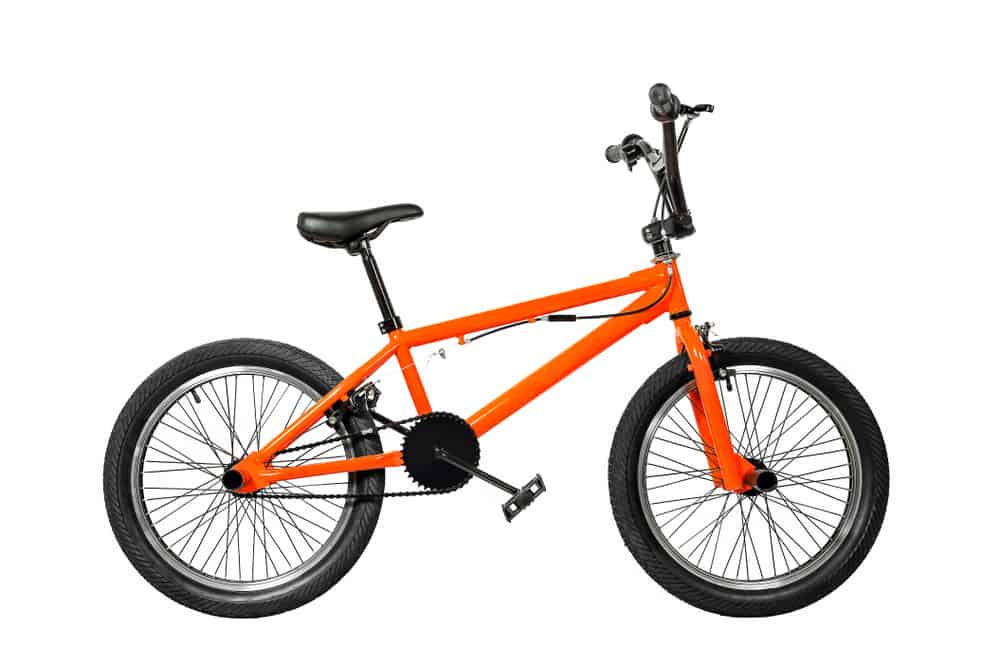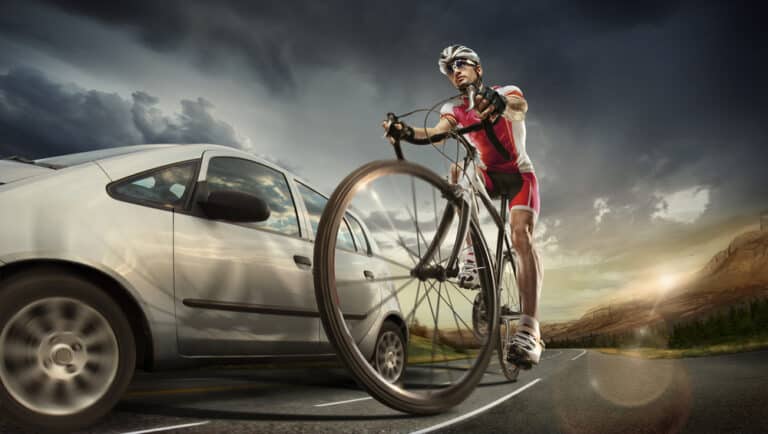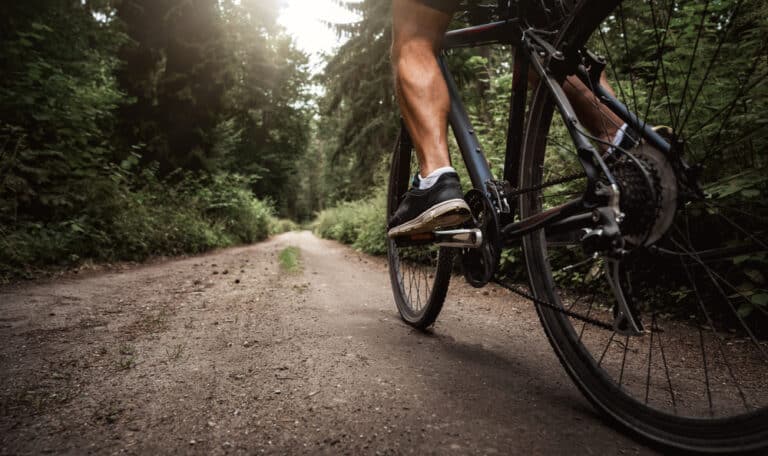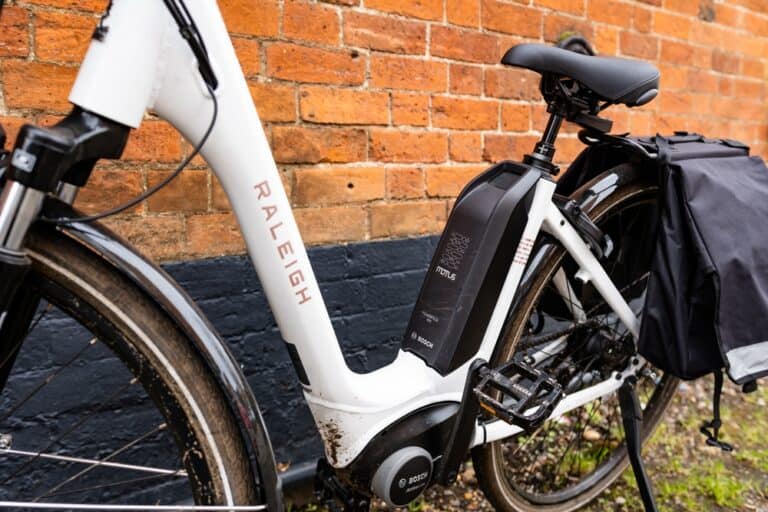BMX Mountain Bike Hybrid

If you’re looking for a dirt track bike that combines the rugged durability of a mountain bike with the lightweight, easier-to-handle frame of a BMX bike, then a BMX Mountain Bike hybrid – or a Dirt Jump bike –seems exactly what you need. But are they a good compromise, and are they worth it?
A BMX Mountain Bike hybrid — called a Dirt Jumper or Slopestyle — combines mountain bike durability with the smaller wheel and low, sloped seat of a BMX. They are good for jump height and aerial tricks but not trails, and a customized MTB may be a better choice.
Many people might be confused by the idea of a mountain bike and BMX hybrid because, at first glance, they two look very similar, but they’re built to do different things. The difference lies not only in the frames, the construction, the tires, and the brakes.
What is the difference between a BMX and Mountain Bike?
BMX has become a generic term, and people call all kinds of off-road bikes – including mountain bikes – BMX, but there are three styles of BMX. The first BMX bikes were styled after motocross motorbikes and were intended for short-track dirt racing.
Mountain bikes are usually aimed for use on heavy off-road trails with lots of drops and inclines. They’ll cover longer distances than a BMX and have much sturdier frames, suspension systems, and braking, adding to the bike’s weight.
BMX Bikes
The standard BMX has a lightweight frame and powerful rear brake. They are used mainly for dirt racing, can hit speed over short distances, and are the familiar 20-inch wheel bikes used in BMX racing. Race bike tires are between pavement tires and dirt tires and are knobbier for better grip.
Standard BMX bikes have frames made from Chromoly steel or aluminum, with aluminum making for a lighter, faster bike. The lighter the bike, the higher its price tends to be. They also have small saddles, and the riders often stand up for better speed.
Most BMX bikes have a 20-inch wheel (though there are larger 24″ cruiser options), and for the dirt racers, manufacturers aim to keep the bike light, so the wheels normally have 32 spokes.
If you see people on BMX-style bikes doing tricks and stunts at the local skate park, this is more likely to be a Freestyle BMX, which has a sturdier frame and a steeper rise in the handlebars to allow for more movement.
Freestyle bikes will have much wider tires than a standard BMX and are designed mainly for use on pavements and indoor tracks. Freestyle has both front and rear brakes to allow for precision in tricks. They are usually fitted with U-brakes for even greater control.
While the wheels are still 20″, they normally have more spokes for added durability, as speed is not the focus. Freestyle bikes will have 48 spokes.
Mountain Bikes
While Mountain Bikes have a somewhat similar style at first glance, they are designed for longer, more comfortable rides, have larger wheels, braking designed to handle steep slopes, and have heavier suspension in both front and back.
Mountain bike riders will rarely spend much time standing to gain speed, as BMX racers do. Hence, saddles are larger, usually at a different angle, and generally more comfortable sitting on them for longer stints.
One of the biggest differences is the gears. BMX bikes are meant to make short tracks at speed and often only have a single gear, whereas mountain bikes need to deal with hills and inclines, so they come with more gears to enable a rider to tackle different grades of steepness.
The tires on a mountain bike are usually knobby to deal with the rough terrain and are wider than standard street bikes. The wheels are normally 26″ and range between 24, 28, and 32 spokes, depending on the mountain bike style.
These specs bring us to the BMX Mountain Bike Hybrid – what exactly makes a hybrid bike or dirt jumper?
What Is A Hybrid BMX?
A Hybrid BMX is also sometimes called a Dirt Jumper, and it’s essentially a BMX with the additional suspension that a mountain bike has. Dirt Jumpers pair the heavy-duty frame of a freestyle BMX with the front suspension of a mountain bike.
The wheels are usually bigger than the standard BMX 20″ and are generally 26″ (in comparison, Mountain bikes come in 27.52 and 292 wheel sizes).
They still have the sloped saddle of a BMX, but instead of using U-brakes, they generally have disc brakes like most mountain bikes.
Another BMX Mountian Bike Hybrid is the Slopestyle, which is intended more for downhill slopestyle courses. Again, it has a low BMX frame, sloped seat, and mountain bike wheels but boasts back and front suspension.
The slopestyle is a bike for people who love doing big downhill jumps and want maximum air time. As with other BMX-style bikes with the sloped seat, the riding position on a slopestyle will mean you spend much time standing on the pedals rather than seated.

Can You Use A BMX Bike For Mountain Biking?
A BMX is not designed for use on a mountain bike trail. BMX bikes are meant to be used on short tracks for speed or for doing jumps and tricks. While you can take a BMX on a mountain trail, the low, sloped seat design will make riding a trail a fairly uncomfortable experience.
Mountain bike gears are meant to enable riders to climb steep hills and their brakes to deal with long steep downhills. BMX bikes, in contrast, usually only have a single gear and are meant to deal with short, fast tracks and to set the rider up for jumps and gaps.
Hydraulic disc brakes on a mountain bike give a rider control when dealing with long descents, and the tires give a mountain bike better grip over various terrain, including loose gravel, mud, and fresh loam.
BMX bikes don’t have the grip necessary to deal with a longer MB trail and can be dangerous for the rider. BMX bikes also have a less powerful braking system, using U-brakes, which can stop abruptly, but usually have less slow control for descents.
When it comes to hills, the BMX single gear is no match for taking on long inclines, and the only way for a BMX bike to clear a hill is if you have built up enough momentum beforehand so that the speed can take you some of the way.
Is There A Hybrid Mountain Bike?
When people talk about hybrid mountain bikes, they’re usually referring to a hybrid bike that combines elements of off-road mountain bike ruggedness with the smooth speed and lightness of a regular street bike.
These hybrids make excellent commuter and weekend trail bikes as they pack the best of both worlds into a single frame. They utilize the multiple gears, disc brakes, and front suspension of a mountain bike, pairing it with the road bike’s smoother tires and lighter-weight frame.
However, these bikes are set up to be good all-rounders for commutes and longer trails and are not designed for the jumps, gaps, speed, and tricks that BMX bikes offer.
If you’re looking for a bike you can use for general off-road use mixed with pavement, then a hybrid is a good choice. If you’re planning on using your dirt bike on treacherous off-road trails with heavy drops and steep hills, then a mountain bike is the better option.
A BMX bike will be much better suited for short, packed dirt courses, ramps, and street tricks.
Is a Dirt Jumper better than a BMX?
If you’re still considering a hybrid BMX Mountain bike like a Dirt Jumper or Slopestyle, you need to consider what you will use it for.
A DJ or Slopestyle is still not going to make a good hybrid bike you can use for mountain biking, but it will be great for getting better height on jumps and better control for air tricks.
If high jumps and air tricks are your goals, look at a Dirt Jumper – they’ll handle the rougher courses with high jumps and rocky ground. They will not be a good choice for road work and will be uncomfortable.
BMX bikes are also not suited for long road rides but will still be more comfortable than a Dirt Jumper or Slopestyle.
A standard hybrid might be a better option if you need a bike that can handle roads and dirt tracks. You can, if you’re a skilled rider, perform tricks with a hybrid bike, but you run the risk of bending the wheels and breaking parts, as it’s not designed to allow for the smooth, clean landing of a BMX.
Should I Buy a BMX or a Mountain Bike?
As you can see, deciding which bike to get will depend on what you will mainly be using it for and what you hope to get out of it.
It would help if you also thought about what you prefer in a bike – are you looking for high control braking, fast braking, multiple gears, single gear, or do you prefer to stand up to peddle, or do you want to stay seated most of the time?
You can also look for a mountain bike with specs closer to a BMX.
For example, you’ll want a rugged, durable frame, and if you prefer going on trails, choose a 27.5″ wheel over the more standard 29″. The smaller wheels will allow for more precise biking, while the larger wheels give you an easier ride.
Look at the width of the tires – thinner tires with a knobby grip will give you better speed over dirt trails, but if you want to do tricks or you’re riding on rough MTB courses, look for fatter tires with better traction and rollover, making your ride smoother and safer.
Customize your bike further by choosing a suspension type that suits your terrain. If you’re taking on tricks, high jumps, and rough ground, aim for double suspension, but if you’re aiming for speed and flatter courses, you only need front suspension.
Conclusion
A BMX Mountain Bike hybrid makes for a great bike if you are looking for a fun, durable bike for tricks, slopes, and getting great height for aerial tricks. As mountain bikes, they are lacking in multiple gears and comfortable seating for longer trail rides.
The hybris combine the braking power, heavier suspension, and durable frame of a mountain bike with the low frame and 26″ wheels of a BMX cruiser, giving you more control. Modifying a hard trail mountain bike to spec will give you a more well-rounded bike for longer rough mountain trails.







